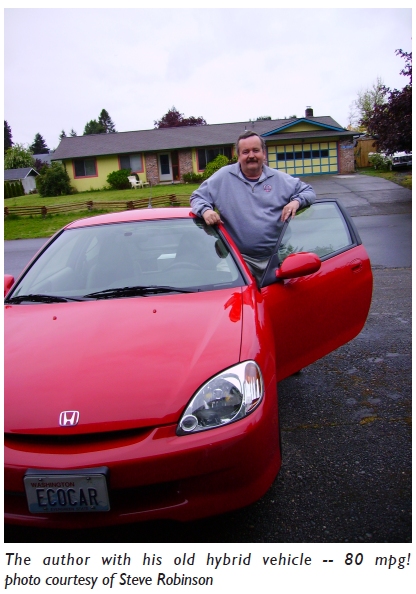Transportation: Thinking Out of the BoxBy Steve Robinson
Dealing with such issues will be like slapping on bandages until that bigger underlying problem is handled. That's not so easy. The Census Bureau says the latest major growth source is children of recent immigrants, 60 percent from religious backgrounds that oppose any form of birth control. A look at the total overall numbers reveals an expansion of 830,000 people statewide over the past decade, and 50,000 in Thurston County. Some leaders predict population expansion will slow, but we're sitting on a powder keg. Consider the population change in the country over the past 50-60 years. It took hundreds of years to reach the level it did by 1950. Since then it has more than doubled. Despite all predictions, today's population could easily double again in another 50 years, creating an unlivable situation with natural resources, food shortages, water and transportation in a critical condition. We already push the envelope beyond a sustainable condition. There are some advantages to population expansion, such as getting more representation in Congress. But from an environmental perspective, it creates massive challenges, and the need to elect people to office who have the courage to acknowledge these realities is resolute. They must think out of the box and have creative, pragmatic solutions. Beyond that, it's important for citizens to realize their responsibility doesn't end at the ballot box, and that complaining about symptomatic conditions simply isn't enough. Each of us must take action. Having smaller families is a personal choice. But, it's one that goes straight to the heart of the problem we all face. As with the hemorrhaging patient, it's important to apply the bandages. Dealing with the symptoms by shutting off the water, fixing leaks and using low watt bulbs is important. It's also important to do what you can do to cut down traffic. You contribute to the problem. Turn it around and help contribute to the solution. When you can walk, do it. When you can bike, do it. When you drive an electric car, it really helps, as does carpooling and using mass transit. A logical solution to having too many cars on the road is to reduce the number of cars. Every time we expand the roads to accommodate traffic, we may ease traffic flow - temporarily - but it simply is not the best environmental solution. Expansion of roads creates more impermeable surfaces, encourages more traffic, poisonous non-point pollution and CO2 emissions and acidified waters. These effects, plus the removal of more property from open space and water soluble landscape destroys more animal habitat. The better solutions are definitely walking, biking, carpooling and mass transit, as well as telecommuting. These solutions are largely in your hands, as is the ability to sway public opinion and political decisions. Let's learn from the experiences of others. The Chesapeake Bay Program, for example. Chesapeake is the largest estuary in the country. One of its ongoing challenges, despite the billions of dollars spent in efforts to turn around massive long term challenges with water quality and traffic gridlock, was extensive increases in population. One of the key solutions they've found is to stop building urban areas based on interstate freeways and focus development near mass transit centers. The result has been more open space, improvements in water quality, less traffic, closer knit communities, happier lifestyles and better livability overall. Our Department of Transportation has based its future objectives on three key strategies: strategically adding road capacity, operating the system we have efficiently and providing choices that help manage transportation demands. With the potential for additional vehicles, cutting down on the number of vehicles must be a far greater objective. Thinking creatively to achieve it involves vision that goes beyond the expansion of roadways. Seriously consider concepts espoused by such visionaries as Port Commissioner George Barner, who advocates a north-south as well as east-west trolley from the farmers' market area. Consider the economic/cultural advantages of a north-south passenger ferry that connects with Link, as well as the expansion of Link, and the development of cultural/museum type facilities in the port/downtown area. Good choices will help our area thrive in an environmentally-friendly way. Steve Robinson is a SPEECH board member.
Back to Home page. |

 Gridlock on our roadways is not just a product of poor planning, but a symptom of a much bigger underlying problem - overpopulation. It's nonetheless important to deal with the gridlock, for many reasons. We all want to cut down on the hours we spend in idling traffic. We also want to reduce CO2 emissions and oil leaks.
Gridlock on our roadways is not just a product of poor planning, but a symptom of a much bigger underlying problem - overpopulation. It's nonetheless important to deal with the gridlock, for many reasons. We all want to cut down on the hours we spend in idling traffic. We also want to reduce CO2 emissions and oil leaks.